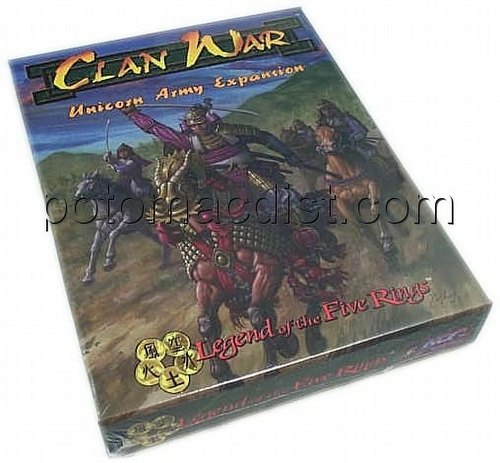
This was done with The Spirit Wars in 2000, when the design was changed to five non-interlocking circular symbols depicting each of the five elements of the game (Fire, Air, Earth, Water and Void). Starting with the release of Pearl Edition in 1999, the card fronts were changed to a simpler, cleaner look that allowed for more card text, as well as returning the visual focus of the card on the art, rather than the borders of the card.įollowing a legal issue with the International Olympic Committee, which has trademark-like rights in the United States to all designs featuring five interlocking rings, it was agreed that Wizards of the Coast would change the card back. Originally, cards featured intricately ornate front sides, while the back of the card, either black or green, featured five interlocked rings and the words "Legend of the Five Rings". The release of Lotus Edition (in 2005) and Samurai Edition (2007) saw extensive changes to several aspects of the game.
#LEGEND OF THE FIVE RINGS 3RD EDITION FAQ FULL#
Alderac Entertainment acquired the rights to publish the game in 2001, and full rights over the game within the following years, and have since published the game. In 2000, at the behest of Wizards' mother company, Hasbro, the intellectual property to the game was put up for sale. Five Rings Publishing Group (FRPG) took over the intellectual property shortly thereafter, before being purchased by Wizards of the Coast in 1997. It was first previewed at Gen Con in 1995, followed by the release of the first set, Imperial Edition, in October of that year, beginning the Clan War arc. The game was created by Alderac Entertainment Group and published by Isomedia.
4.8 The Age of Conquest (Emperor Edition).  4.7 The Destroyer War (Celestial Edition). 4.6 The Race for the Throne (Samurai Edition). 4.5 The Age of Enlightenment (Lotus Edition). 4.4 The Rain of Blood (Diamond Edition). 2.3 Introduced during the Hidden Emperor arc. Legend of the Five Rings has garnered many accolades throughout the years, including several Origins awards (such as the most recent 2008 award for best CCG with Samurai Edition) and the 2008 Scrye Players Choice Best CCG Award for Samurai Edition. Two novel lines, covering the Clan War and Four Winds arcs, have been published. Many of these stories reflect the result of tournaments, where players use their decks to determine which faction will claim a particular prize within the storyline. Games can be very long, with some matches lasting hours.Ī major distinctive feature of the game is the importance of the storyline: new fiction pieces advancing the story of Rokugan are published on a weekly basis, in addition to being released with every expansion, and in a quarterly publication, the Imperial Herald. The card game shares some similarities with Magic: The Gathering but has its own game mechanics and flavor, providing "passive" win conditions like the Enlightenment Victory, as well as a version of Magic's goal of destroying the opponent. L5R takes place in the fictional empire of Rokugan from the Legend of the Five Rings setting, where several clans and factions vie for domination over the empire. Legend of the Five Rings ( L5R) is an out-of-print collectible card game created by Alderac Entertainment Group in 1995 and published until 2015, when it was announced that the game would be discontinued for a rules-incompatible successor that will be part of Fantasy Flight Games' Living Card Game line. JSTOR ( April 2008) ( Learn how and when to remove this template message)ĭavid Seay, John Zinser, and David Williams. Unsourced material may be challenged and removed.įind sources: "Legend of the Five Rings" collectible card game – news
4.7 The Destroyer War (Celestial Edition). 4.6 The Race for the Throne (Samurai Edition). 4.5 The Age of Enlightenment (Lotus Edition). 4.4 The Rain of Blood (Diamond Edition). 2.3 Introduced during the Hidden Emperor arc. Legend of the Five Rings has garnered many accolades throughout the years, including several Origins awards (such as the most recent 2008 award for best CCG with Samurai Edition) and the 2008 Scrye Players Choice Best CCG Award for Samurai Edition. Two novel lines, covering the Clan War and Four Winds arcs, have been published. Many of these stories reflect the result of tournaments, where players use their decks to determine which faction will claim a particular prize within the storyline. Games can be very long, with some matches lasting hours.Ī major distinctive feature of the game is the importance of the storyline: new fiction pieces advancing the story of Rokugan are published on a weekly basis, in addition to being released with every expansion, and in a quarterly publication, the Imperial Herald. The card game shares some similarities with Magic: The Gathering but has its own game mechanics and flavor, providing "passive" win conditions like the Enlightenment Victory, as well as a version of Magic's goal of destroying the opponent. L5R takes place in the fictional empire of Rokugan from the Legend of the Five Rings setting, where several clans and factions vie for domination over the empire. Legend of the Five Rings ( L5R) is an out-of-print collectible card game created by Alderac Entertainment Group in 1995 and published until 2015, when it was announced that the game would be discontinued for a rules-incompatible successor that will be part of Fantasy Flight Games' Living Card Game line. JSTOR ( April 2008) ( Learn how and when to remove this template message)ĭavid Seay, John Zinser, and David Williams. Unsourced material may be challenged and removed.įind sources: "Legend of the Five Rings" collectible card game – news 

Please help improve this article by adding citations to reliable sources. This article needs additional citations for verification.







 0 kommentar(er)
0 kommentar(er)
